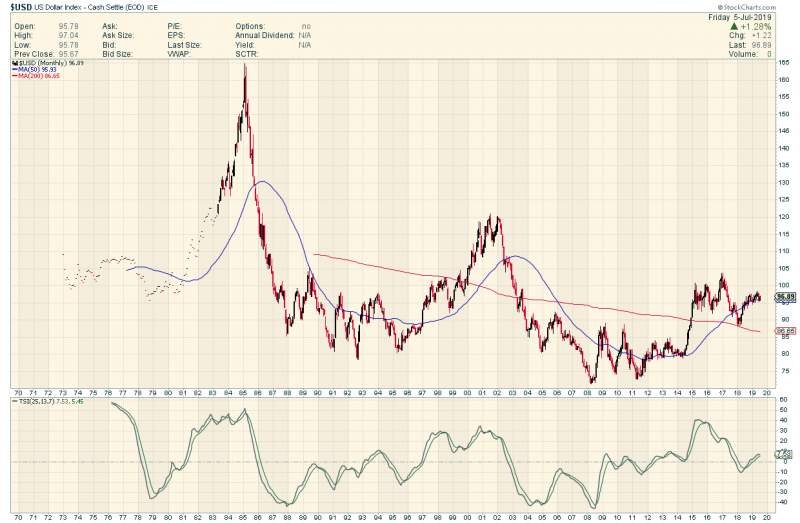I have a Bone to Pick
With all due respect to all here.
Call it a pet peeve.
Regarding Dollar Long Term Cycles
Trying to analyse what the Dollar ( as measured by the almighty Dollar Index ( or DX)
using a supposed 15 year or 16 year or 18 year or whatever …cycle ….seems ridiculous to me.
Because IF there is such a cycle ( low to low) it is a very very small sample size .
Statistical Insignificance
The Dollar Index ( Dollar value as measured against a basket ( case) of currencies has only been tracked for MAYBE
45 years basis Stockcharts…..so at most one can demonstrate 2 or 3 full cycles……This is NOT a significant sample size to be of any use at all. Never mind that back in the 70s and 80s there was no Euro ( which is 57% of the DX presently….the German mark was the substitute then ….How do we know that the german mark was 57% of the DX ?
This DX obsession is ridiculous IMHO….and so is trying to call long term cycles on it.
Shorter term cycles a la Surf City…of course are fine ( much more data)
End of Rant

Bone picked!
However, it’s the only data we have to go on. Small sample size or not, that’s too bad. The bottoming pattrerns in the late 80s to 1992 look very similar to the patterns in mid 1990s. Both are pre-Euro of course. I was about to point out that one was not pre-euro then I realized I ewas =weong.
I would guess that the USDX had all kinds of stuff in it, like Deutschebank, oops, Deutschemark, French Franc and all that other European stuff that disappeared with the start of the Euro (Dutch Guilder, etc?)
What about commodity cycles previous to these dollar index cycles?
I can never make up my mind whether the commodity cycle runs inverse to the dollar or if the dollar runs inverse to the commodity cycle. I’m not a big cycles adherent because they all seem to have different lengths. It;’s a bit too precise in its predictions on imprecise data, same with Elliott waves in my view. All useful tools … but … what matters to me is just price.
Hi Fully,
How about the bull and bear markets for gold too? All since 1971-ish 15 August and all that. That’s 48 years and only two secular gold bulls since then.
Agree…so my point is there is no proven long term cycle in gold either
short term cycles ( months / weeks ) have enough of a track record but 15 year to 20 year cycles do not
Fully agree Fully. Small sample sizes cause statistical lies. I have taken more statistics classes than I ever wanted to, but the one thing I learned is that it is very easy to be misled by statistics unless you completely understand every part.
One reason to keep an open mind, despite the (so far) cyclical behaviour of DXY.
Yes, but … draw a statistical regression (preferably OLS) line of best fit through the $USD index and through $GOLD and one would easily see the $USD will continue to move towards zero and $GOLD relative to the dollar will continue to increase. That is all one needs to know if they are a long term investor. Hold the real thing and get rid of the toilet paper.
Toilet paper can still buy a nice car.
touche
Good point, although, one should not buy a new car with $USD because it also will depreciate as fast as $USD … maybe buy used with ~30k miles on it
I believe this fits here…http://plata.com.mx/enUS/More/379?idioma=2
One salient point with this US dollar thing is that most of that 45 year period was an inflaitonary period qorldwide (OK there was “disinflaiton” in the 80s compared to the peaks in 1980 or so but there was still inflation) and now we are arguably in some kind of deflationary cycle since the crisis of 2008, similar to that inb the 1930s.
We have had until recently no US dollar action that can cover an event like 1929-33 because the dollar was on the Gold Standard then. In other words, this dollar chart doesn’t even cover one Kondtratieff cycle. There are those who might believe that the senior currency would be chronically strong in a deflationary cycle and that makes sense because of deleveraging and the need to repay US reserve currency dollar debts by selling everything else, including the kitchen sink and any cars bought on credit.
We have not had the bank clearout or the market cleaing that happened in the 1930s. Maybe this can’t happen with fiat money that can be issued seemingly with impunity by central banks including and possibly especiually the Fed. All the money printing QE1 ,2 & 3, does not seem to have had a negative effect on the USDX because it is not far from 100 where it started in 1973. Of course it’s also happened in the EUR, JPY and GBP and CHF zones so that balances out the USD depreciations.
So we really have no model for the current situation. It’s all suck it and see.
This is why I had wondered if the dollar would reverse to the upside for a secular bull over the next 40 years, starting with the almost double bottom in 2008 and 2011 on the advent of the financial crisis and credit crunch, which also marked the probable nemesis of the Euro.